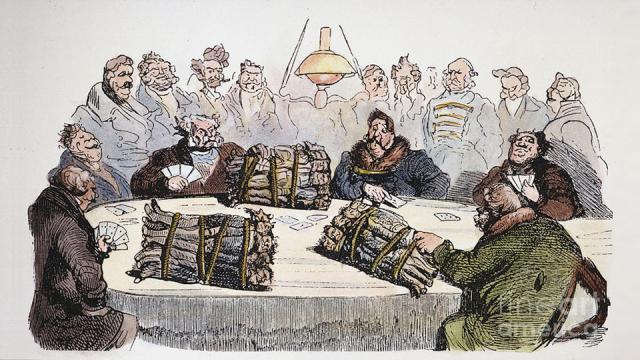
This is the fourth installment in a seven-part series running throughout the week. Read the first, second and third parts.
The Bubble Economy
By 2002, a full-blown financial and real estate bubble was underway. For the first time in history, people imagined that the way to get rich was by running into debt, not by staying out of it. As the Federal Reserve pushed interest rates down, prices for real estate, bonds and stocks rose—being worth whatever a bank would lend.
The problem for pension funds was that the falling interest rates that fueled the bubble’s rising “capitalization rates” of income into bank loans meant lower current returns. This made it more expensive to buy a retirement income. By 2011, California’s giant pension plan, CalPERS, was making only a 1.1 percent return. Yet as noted above, nearly all pension funds since the 1980s have made their projected ability to pay retirees on the assumption that they can make at least an 8 percent rate of total returns (interest plus dividends) year after year. By the time interest rates hit their bottom (1 percent), there was no more source of capital gains from higher bank liquidity lowering them further.
Pension funds tried to catch up by speculating in financial derivatives that had no counterpart in tangible investment or employment. To make matters worse, financial fraud was effectively decriminalized as the Justice Department, Securities and Exchange Commission, and other regulatory agencies refused to prosecute. Fraud became part of the “free market.” Regulatory agencies were understaffed, and administrators were chosen who were committed to not enforcing the rules. Many appointees reaped their rewards for inaction by what the Japanese called “descent from heaven.” They received enormously well paying jobs when they left these agencies to join the sectors they had been charged with regulating. Politicians made eloquent calls for new laws—while refraining from using those already on the books that had long been used.
Banks and pension funds lent mainly to other financial institutions, not to finance new capital formation or employment. The new era of asset-price inflation had changed the economic aim—in fact, the foundation of economic solvency—to making capital gains by debt leveraging. By 2008, the bubble dynamic burned out in what Hyman Minsky called the Ponzi stage of the financial cycle. Investors and speculators paid their backers by borrowing the interest—and even borrowing the hoped-for price gains for real estate, stocks, and bonds. Companies bid up prices for their own stock by using cash flow and even by borrowing—while increasing earnings by outsourcing production and downsizing employment.
Tax policy also favored making capital gains rather than earning wages, salaries, or profits. And the Federal Reserve was able to inflate asset prices by flooding the economy with enough credit to lower interest rates, enabling banks to capitalize a rental or corporate income at a higher multiple in lending to new buyers. What President George W. Bush euphemized as “the ownership society” was becoming an increasingly debt-leveraged economy. Raising home ownership rates for racial and ethnic minorities (and for low-income families in general) were achieved by loading them down heavily with debt at exploding “adjustable” mortgage rates.
Alan Greenspan urged homeowners who chose to stay in their property to “cash out” on their home equity by borrowing and spending the loan proceeds as if it were income. As wages and salaries had stagnated since the late 1970s while medical costs and other prices rose, such borrowing more against one’s home became the only way of maintaining living standards for many families. The Protestant Ethic of living off interest, not eating into capital or going into debt, was becoming obsolete. Debt leveraging was applauded as the way to get rich.
But this created a policy quandary once the process had run its course by lowering interest rates and easing credit terms. If governments let interest rates rise again, this would cause losses in the capitalized value of real estate rents, corporate earnings, stocks, and bonds. So central banks were locked into low interest rates, such as the Federal Reserve’s Quantitative Easing policy in 2010 and 2011.
This turned the dream of pension fund capitalism into a nightmare of insolvency. Financializing pensions by steering revenue into the financial markets to build up claims on the economy had an opposite effect from direct investment to earn revenue on a current basis. Pension funding helped bid up prices for financial assets while interest rates were falling. But when the bubble had run its course the economy was left loaded down with debt. Its carrying charges blocked recovery by diverting spending away from markets for goods and services.
Debt Deflation in the Post-Bubble Economy
Paying down debts raises the reported rate of saving, because the negation of a negation (lower debt) is counted as a positive (saving). This is the form that saving is taking in the U.S. economy today: reducing credit card balances and paying down mortgages, student loan balances, and other obligations. This is not a buildup of funds available for spending. Most people have less to spend as they pay debt service. And they are less able to borrow as banks are pulling back their credit lines, seeing the economy become more risky and hence less creditworthy.
Economies shrink when debt service diverts spending away from consumption and investment. And as economies shrink, financial risks rise. Companies cannot borrow by issuing their own commercial paper IOUs, because the wave of deregulation has destroyed the trust needed for financial markets to work. And banks are not relending their inflow of loan paybacks to the “real” economy, but entirely to other financial institutions; or, they are rebuilding their reserves of government securities, or speculating on arbitrage gambles.
Credit has dried up even more drastically in Europe. An obsession with government budget deficits prevents them from supplying the economy with spending power. Decades of bank propaganda have implanted a false memory in Germany’s population. The Weimar hyperinflation in the early 1920s is blamed on the Reichsbank financing a domestic budget deficit. What actually happened is that the central bank tried to meet Germany’s unpayably high reparations by printing reichsmarks and desperately selling them on the foreign exchange market to raise the hard currency being demanded by the Allies. The problem was not domestic money creation to finance German spending, but war debts denominated in foreign currency.
Bankers have crafted a narrative that has drowned out memory of what actually happened in history—and also misrepresented how central banks are supposed to work in practice. In a bold attempt to deter today’s governments from having their own central banks monetize their deficits, bank lobbyists and their pet academics parrot the absurd falsehood ad nauseam that central bank financing of budget deficits is inherently inflationary—indeed, hyperinflationary, likely to bring on economic collapse. The only “stable” policy, bankers insist, is for governments to borrow from them—as if they are “honest brokers” wisely lending only for economically viable productive purposes.
Even a cursory look at recent U.S. and British experience should dispel the idea that central bank money creation must inflate commodity prices. The Bank of England and the Federal Reserve do what central banks were founded to do: monetize public budget deficits. This is what is needed to save economies from plunging into depression today—although, in fact, the deficits have stemmed from bailing out the banks and financial sector. Since 2006, the Federal Reserve has overseen the largest new money creation in history. Yet consumer prices and wages barely rose. Likewise in Britain, the pound has held steady, as has the dollar. What has occurred is a debt-leveraged real estate bubble collapsing into negative equity. Yet Europe remains committed to austerity, pushing its economies deeper into depression. Latvia and Greece limp along as object lessons to show how financial and fiscal austerity leads to plunging employment, bankruptcies, collapsing property prices, and foreclosures. Labor is unable to find work and emigrates. So debts end in default and national budget deficits worsen.
Even as economies are being driven into debt deflation and depression, the “Troika” of E.U. leadership, the European Central Bank (ECB) and International Monetary Fund (IMF) are calling for balanced budgets instead of public spending to revive employment. Neoliberal ideology holds such spending responsible for the inability to pay creditors. It demands that governments pay by raising taxes on the nonfinancial sector—for bad private-sector debts as well as public debts.
Ignoring the problems caused by private-sector debt and bad bank lending frees the banks from blame, as if their lending were not the main cause of raising prices for houses and other assets. It adds injury to insult by demanding a “solution” that gives the banks a windfall. Neoliberals seek to use the financial crisis as an opportunity to push a grab bag of benefits. For starters, they urge that progressive taxation be abandoned in favor of a flat tax, excluding capital gains and other rentier income. The policy is to be capped by selling off public assets to bank customers. So banks are to be given even more subsidies to keep them afloat under their own bad- debt burden that has wiped out their reserves. These solutions would impose fiscal deflation on top of debt deflation.
Misrepresenting the debt problem as a demographic one, financial lobbyists point out that people are living longer. They then claim that governments cannot balance their budgets without slashing Social Security, just as the private sector has been downscaling defined benefit pension plans into amorphous “defined contribution” plans. (Wages are withheld in the hope that Wall Street money managers will make capital gains.) In this reading, the “solution” to the economy’s debt overhang is not to write down debts, nor to restore progressive taxation and pay Social Security, health care, and other public spending out of the general budget. The social safety net is to be scaled back so as to reduce taxes and become more “competitive.”
3 WAYS TO SHOW YOUR SUPPORT
- Log in to post comments



















